On this page...
Print the complete Flagger Training Manual
To save this page as a PDF: Press Ctrl+P (Cmd+P on Mac), select "Save as PDF" from destination, ensure "All" pages is selected, and adjust settings if needed. Then click "Save", name your document, and then click "Save" again.
To print this page: Press Ctrl+P (Cmd+P on Mac), select your printer, ensure "All" pages is selected, and adjust settings if needed. Then click "Print".

Rules of Conduct
List items for Rules of Conduct
Flagging is an important responsibility and should be carried out with authority and dignity. Courtesy and a professional attitude are vital in gaining the respect of the traveling public. The image you project as a flagger will affect the public’s attitude toward the whole project and your organization.
The following guidelines will make you a safer and more effective flagger.
- Park your vehicle outside the work area, well off the roadway.
- Make sure your apparel and equipment are clean and neat.
- Make sure proper signs are in place.
- Become familiar with the work activities so you can answer motorists’ questions.
- Discuss a reasonable relief schedule with your supervisor or crew leader.
When two or more flaggers will be working together, make sure one flagger is designated as the flagger in charge (the other flagger[s] will coordinate their activities accordingly). Also, make sure you:
- Are positioned so you can see each other or have two-way radios for communicating.
- Use a pilot car if you cannot see other flaggers or do not have two-way radios.
Do not leave your position for any reason until relieved.
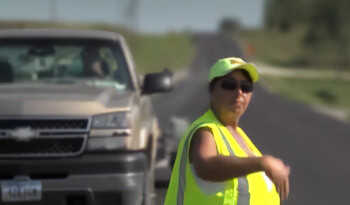
- Always remain standing and never turn your back on traffic.
- Stand alone. Do not mingle with the work crew, the traveling public, or other people.
- Stay alert. Don’t be distracted by the work operation.
- Be friendly and polite with the public, but do not engage in small talk.
- Never argue with the occupants of a vehicle.
- If a driver refuses to obey instructions, inform your supervisor or crew leader as soon as possible without leaving your post. Carry a pocket notebook for recording:
- Information to identify the driver.
- Description of the vehicle and license plate number.
- Circumstances involved in the incident.
- Be alert to the needs of emergency vehicles. They should be given priority, but only when safety will not be compromised.
If a crash occurs in or near the work zone:
- Do not leave your post.
- Warn other flaggers and workers.
- Advise your supervisor and/or authorities.
- Record any pertinent information.
Flagger Apparel & Equipment
List items for Flagger Apparel & Equipment
In addition to being dressed neatly, flaggers need to be dressed for safety. In particular, flaggers are required to be easily visible to traffic. Flaggers shall wear the following required items, even when serving as a replacement for a short period ( illustration).
- ANSI 107 Class 2 apparel (vest, shirt, jacket, or rain gear)
- Headwear meeting ANSI 107 requirements (a hard hat in the same colors is an acceptable alternative to the headwear (soft cap, stocking hat, or hat) and may be required by OSHA or your employer in certain circumstances)
- STOP/SLOW paddle. Retroreflective sheeting shall comply with applicable specifications
- ANSI 107 Class E pants
- Highly visible retro-reflectorized wristband or gloves (optional)
- Flashlight with red glow cone, lantern, or other lighted signals that will display a red warning light
- Lighted flagger station
- Hand-held radio for communications
- Adverse weather gear
- Pad and pencil
- Air horn or whistle
Flagger's Position
List items for Flagger's Position
In rural areas, flagger stations should generally be located:
- A minimum of 350 feet (105 m) in advance of the work area
- Where the flagger is visible to approaching traffic for at least 500 feet (150 m) away
Factors such as visibility, traffic speeds and volume, road conditions, and the work being done should be considered in determining your proper location.
Positioning yourself carefully, according to the following suggestions, will help keep you safe during flagging and will assist you in skillfully controlling traffic through the work area.
- Always stand and face oncoming traffic.
- Do not stand in the path of an approaching vehicle.
- Stand where you will be highly visible at all times.
- Do not stand in shadows.
- Do not stand near parked vehicles or equipment that might hide you from approaching drivers.
- Always have an escape route in mind.
Single Flagger Operations
List items for Single Flagger Operations
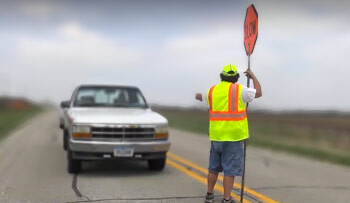
A single flagger can be used when:
- Sight distance is adequate
- Traffic volume is low (less than 2,000 vpd)
- Work zone length 100 feet (30 m) or less.
Releasing Traffic
- Return to the shoulder of the road with the STOP side toward stopped vehicles.
- Turn the paddle so neither STOP nor SLOW can be read by drivers approaching from either direction. Take care not to confuse continuous traffic traveling in the other lane in the opposite direction.
- Motion for traffic to proceed
Two Flagger Operations
List items for Two-flagger Operations
To slow approaching traffic in a two-flagger operation, follow these steps:
- Stand on the shoulder of the road, holding the paddle in your one hand with the SLOW side toward traffic.
- Extend your other arm, and with the palm facing downward, motion up and down slowly to gain driver's attention. If needed for emphasis, this motion can be more forceful.
To stop traffic, follow these steps:
- Stand on the shoulder of the road holding the STOP/SLOW paddle in your right hand, erect and away from your body with the STOP side facing approaching traffic. Never wave the sign.
- Look directly at the approaching driver. Try to establish eye contact.
- Raise your free arm with the palm of your hand toward oncoming drivers. Bring the first vehicle to a full stop.
- Stop other vehicles from this position using the STOP sign, hand signal, and eye contact (Optional: During daytime operations, the flagger may move to the centerline to improve their visibility carrying the STOP/SLOW paddle).
- Remain in this position until you can safely permit travel through the work area.
- Request the first driver to activate the vehicle’s hazard warning lights.
To release traffic in a two-flagger operation, follow these steps:
- If on the centerline, return to the shoulder.
- Hold the paddle in one hand, turn the SLOW side of the sign toward stopped vehicles.
- With your free arm, signal drivers to proceed. Never wave the paddle.
For more information, see the releasing traffic illustration.
Pilot Car Operations
List items for Pilot Car Operations
- When work is performed over a long section of roadway, a pilot car is often used to escort vehicles through the work area.
- Try to limit delays to 15 minutes maximum.
- Stop vehicles in the approved manner.
- Detain all vehicles until the pilot car arrives from the opposite direction.
- After the pilot car arrives and has pulled into position at the head of your column of vehicles, step back onto the shoulder with STOP displayed. Follow the procedure for releasing traffic in the Two-Flagger Operations.
- Refrain from unnecessary conversations with the pilot car driver.
- Turn the SLOW side to face traffic, and motion the pilot car driver and others to proceed.
- Signals will rest on RED.
- Flagger should remain on the shoulder at all times.
- Be alert and face oncoming traffic.
- Signal shall remain on RED while waiting for the pilot car.
- Refrain from unnecessary conversations with the pilot car driver.
- After the last vehicle of opposing traffic has passed and the pilot car has pulled into position at the head of the column of queued vehicles, activate the GREEN signal phase and motion to the pilot car to proceed.
- Continue to extend the GREEN phase until the queue has passed.
- Allow the signal to cycle to the YELLOW phase. The signal will remain on RED to stop the next queue of oncoming vehicles.
NOTE: Flagger station is required to be lighted at night, even when using temporary signals.
Flagging in Different Situations
List items for Flagging in Different Situations
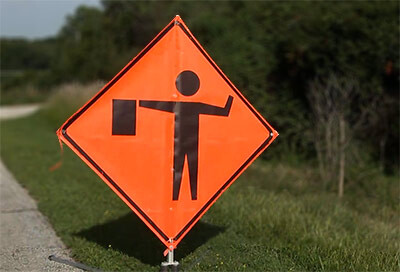
In emergencies, the following equipment and procedures may be used on a short-term temporary basis. However, provide standard traffic control as soon as possible.
If the STOP/SLOW paddle is not available, use a good-quality red flag to regulate traffic in emergency situations.
The flag shall have the minimum:
- dimensions of 24 inches by 24 inches (600 mm by 600 mm),
- minimum 3-foot (0.9 m) handle,
- free edge of the flag should be weighted so the flag will hang vertically even in windy conditions.
Nighttime Emergency Situations
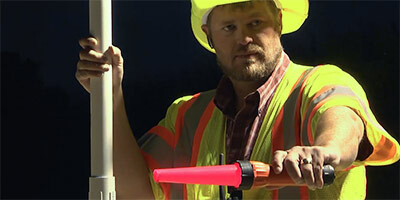
A flashlight with a red glow cone may be used in addition to the red flag. Retroreflectorized clothing shall be worn.
Follow the procedures for stopping and releasing traffic under Two-Flagger Operations.
When flagging near railroad crossings, be sure your flagging station is not located where traffic may be backed up over the crossing. If the flagger position cannot be moved, an additional flagger will be needed to keep the crossing clear of stopped traffic.
- Work in the vicinity of a grade crossing. See Railroad Crossing illustration.
Generally, traffic control procedures are the same for haul road intersections as for other work areas. Follow the procedures for stopping and releasing traffic under Two-Flagger Operations.
- When trucks are making a right turn onto the highway, only one flagger may be required.
- When trucks are crossing the highway or making a left turn, two flaggers may be required, one for each direction.
When work activities occur in an intersection, additional flaggers may be needed.
Communication among flaggers is essential. Do not direct drivers through red lights at intersections with traffic signals. Signals should be deactivated to avoid confusion.
Mobile work zones present particular challenges for flaggers. Because you may be moving down the road with the other workers, your visibility and conflicts from intersecting roads and driveways are continually changing.
Supervisor Guidelines
List items for Supervisor Guidelines
- The supervisor’s involvement is critical to proper flagging and traffic control.
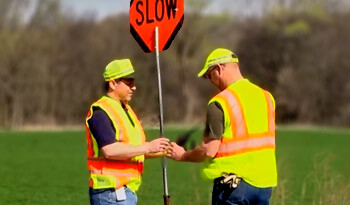
- Be sure flaggers are properly trained and instructed. Impress on flaggers the value and importance of performing their duties properly.
- Provide proper equipment and apparel for flaggers.
- Provide adequate breaks for flaggers.
- Provide relief for flaggers by alternating flaggers and/or pilot car drivers periodically throughout the day.
- Develop a procedure for handling noncompliant drivers.
- Discuss appropriate actions for possible incidents in or near the work zone.
- Drive through the work area periodically to observe traffic control operations. Correct activities not in compliance with this Flagger’s Handbook, the MUTCD and other contract documents.
- Ensure proper signs are in place prior to beginning operations and that they remain in place only as long as they are needed.
Specification 2528.03.J
Remember, you play a vital part in keeping the public and your co-workers safe. If you are unsure of any flagging procedure, ask your supervisor for further explanation.
Iowa Code for Flaggers: 321.256
Iowa Code Section 321.256 states:
No driver shall disobey the instructions of any official traffic control device placed in accordance with the provisions of this chapter.
The STOP/SLOW paddle is an official traffic control device. In addition, Iowa DOT Standard Specifications 1107.09 and 2528.03, K authorize contractors to conduct flagging operations as required to control traffic through work areas.